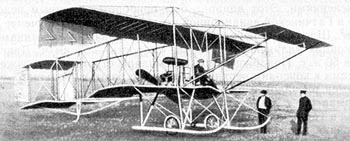
Henry 'Henri', Maurice and Richard 'Dick' FarmanThe Aircraft, L'Avions
Preamble Nomenclature : In general terms the aircraft are named after the individual brother Henri Farman HF, Maurice Farman MF, and the cooperative production F sometimes? known as the 'Horace' Farman. The number of ways the types are listed also varies, eg HF 20, HF-20 and the style I have selected here HF.20. If you know better then I am happy to be corrected on this and any other matter. My one aim is to get it right for future researchers. Licensing : the Farman brothers and I'm guessing Henry (Henri) in particular were keen licensees of their designs. 'Farmans' were built in Great Britain (Aircraft Manufacturing Company), Italy, (Savoia, Fiat, Macchi, Zari and Vickers Terni), Belgium (Bollekens, Nélis), Russia, Greece, Sweden Images : With some types there are a plethora of images available, with others, images are virtually non existant if at all. Some however have also become entangled in the 'information web' discussed above. The author will try to present a 'typical' example of each type and if justified a second or third view. It is not intended at this stage to simply place a copy of every Farman type found on the web or in print. I like my sanity! - Ed. Dictionary : A few terms that may not be obvious to the visitor. Moteur propulsif = Pusher Type; Biplace = 2 Seater; Triplace = 3 Seater; de tourisme = scout; d'entrainement=trainer; de course = competitor; vol=flight. Credits : This information was gleaned from more than a dozen sources on the web and in print, however my starting points were the online works by B. Parmentier and Daniel Brackx
A Brief Introduction As early as 1908 Henry Farman had a school of aviation and construction works at Buc near Versailles. Somewhat later his brother Maurice Farman began to manufacture aircraft and in 1912 the brothers merged their interests in the Farman works at Boulogne-sur-Seine, making many planes of their characteristic pusher biplane type for military and training purposes. also... Henry, Maurice et Dick Farman. Premier atelier de Henry en 1908 à Bouy près de Chalons-sur-Marne. Son frère Maurice installe ses ateliers à Buc. Usine commune rue de Silly à Boulogne-Billancourt. Terrain à Toussus-le- Noble. Cette usine revient à la S.N.C.A.C. lors des nationalisations.
1907-1909Voisin-Farman 1 -> Voisin-Farman 1bis -> Henri Farman 1bis A Turn for the Pursehttp://www.first-to-fly.com In 1907, The Voisins made an airplane for Léon Delagrange, mounting a 50-horsepower Antionette engine and a propeller on the lower wing to push it through the air. Although it had no roll control, Delagrange was able to make short hops of up to 500 meters (1650 feet). As such, the Voisin-Delagrange I was the first European airplane to best the Wright's first powered flights in 1903. Henry Farman also ordered a Voisin aircraft and on September 30, 1907 flew his Voisin-Farman I , making a modest hop of just 30 meters (100 feet). Farman also modified the airplane as he gained more flying experience, eliminating the side curtains, reducing the size of the tail, and adjusting the dihedral angle of the wings, all to reduce drag, improve stability, and make the airplane more maneuverable. However, even in its final form as the Voisin-Farman 1bis as with the unmodified? Voisin-Delagrange I, it had no roll control - Farman made do with an elevator and rudder only.
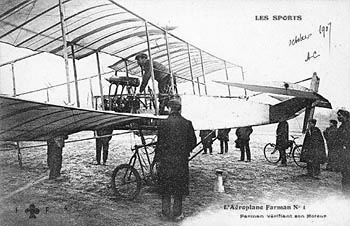 Voisin-Farman I, October 1907 download a 750pixel image
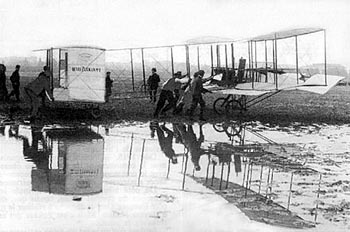 Voisin-Farman I, Issy-les-Moulineaux, 1907 download a 750pixel image
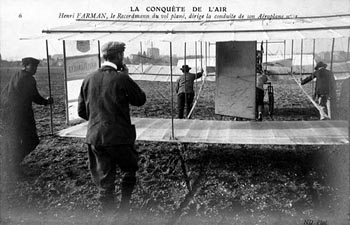 Voisin-Farman I, Issy-les-Moulineaux, 1907 download a 750pixel image
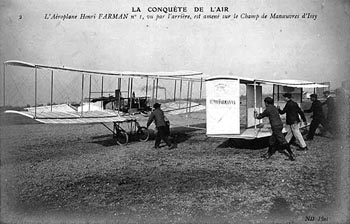 Voisin-Farman I, Issy-les-Moulineaux, 1907 download a 750pixel image
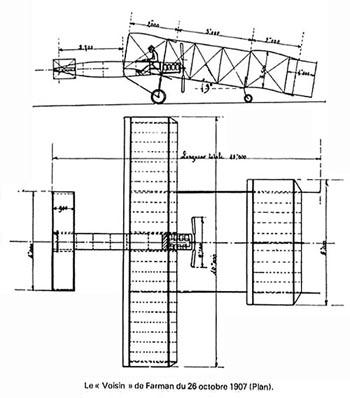 Voisin-Farman I, as of Oct., 26, 1907 download a 750pixel image
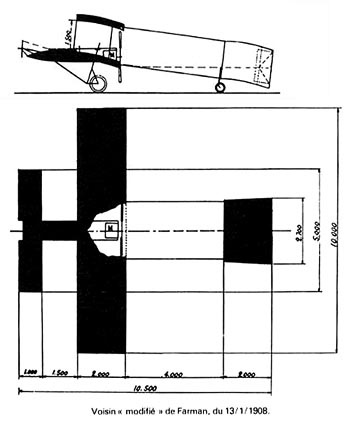 Voisin-Farman I, as of Jan., 13, 1908 download a 750pixel image
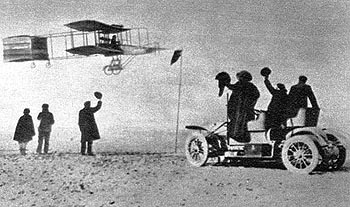 Henry Farman flies the first one-kilometer circuit, January 13, 1908 download a a 750pixel image
On January 13, 1908, Henry Farman took off again in pursuit of the Grand Prix de Aviation and its 50,000 franc purse. He made a flying start, crossing the starting poles about 4 meters or 13 feet off the ground. He flew straight out for about 500 meters, slowly climbing to 12 meters or 40 feet, then made a wide, flat turn, using rudder alone to slide around the marker. He came back and made another turn, crossed the point at which he started, and landed gently.Voisin-Farman 1bis -> Henri Farman 1bis http://members.lycos.co.uk With 50,000 francs in his pocket, [the prize of January 13, 1908], Farman could afford to make further modifications to his aeroplane in preparation for a new flying season. In March 1908 he had the machine re-covered in rubberized fabric and re-engined with a 50hp Renault. The Voisin-Farman 1bis became the Henri Farman 1bis. The new engine did not last long and he reverted to the Antoinette, but Farman's constant tinkering with his plane show how confidently he had grasped the essentials of aeronautics. During the summer he added 'side-curtains' to the wings, to make them true box-kites, and importantly put in ailerons of his own design so that the machine could be banked.
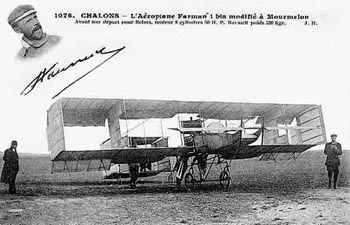 Henri Farman 1bis, 50hp Renault, 'modified' at Mourmelon Henri is on the right and possibly Maurice on the left. download a 750pixel image
Henri Farman 2, J.T.C. Moore-Brabazon 'Bird of Passage'
Voisin and Farman In November 1908 Henri Farman sold his trusty Henri Farman HF.1bis and waited for delivery of a new and improved Voisin. A machine in the Voisin workshops was earmarked for him, but instead the brothers sold it to a wealthy young Englishman newly arrived in Paris, J.T.C. Moore-Brabazon. Farman's relations with the Voisin brothers were already less friendly than they had been.
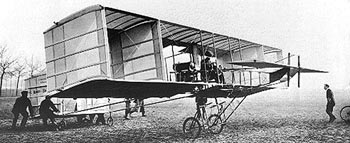 J.T.C Moore-Brabazon aboard his newly acquired Voisin 'Bird of Passage', 1909 Download a 750pixel image
This episode was the final straw. Farman resolved to build his own aeroplanes from now on, and set to work that winter. The result would be the Farman Boxkite aeroplane, [Henri Farman 3 - Ed.] that proved immensely popular with the growing band of amateur aviators. Henry went into business with his brothers Maurice and Dick in order to manufacture and sell the design, and the firm soon rivaled the Voisin company.
Henri Farman 3, HF.3, HF.111, Boxkite, Éole, Militaire
Henri Farman 3 The Henri Farman 3, one of the most famous and widely used of early European biplanes, was the first aircraft produced by Farman's factory in France. It had full ailerons which made it controllable by giving roll, or banking, control as well as sprung wheels on the landing skids to come " ... to earth most perfectly and with the least shock." It won distance, altitude and passenger carrying awards at the Rheims air meet of August 1909. Farman had earlier been the first in Europe to fit practical ailerons to an airplane; a Voison-Farman I bis, in October 1908. The Farman 3 was the first aeroplane to fly from England to Ireland. In the interest of flight safety, the Museum's replica is slightly modified from the original. Specifications: span 34 ft. 6 in.; length 43 ft. 6 in.; takeoff weight 1270 lbs.; engine 50 hp. Gnome seven-cylinder air-cooled rotary (original); 150 hp. Lycoming air-cooled flat four (representation); speed 45 mph.
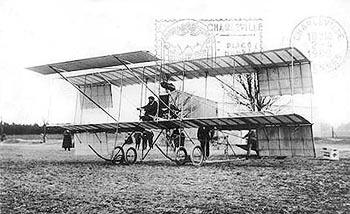 Henri Farman 3 download a 750pixel image
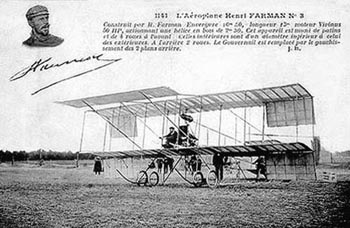 Henri Farman 3 This is of course the same image as above with the building retouched out for the production postcard.
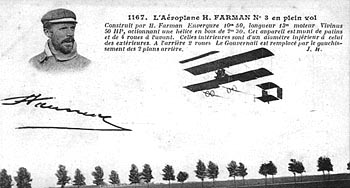 Henri Farman 3 download a 750pixel image
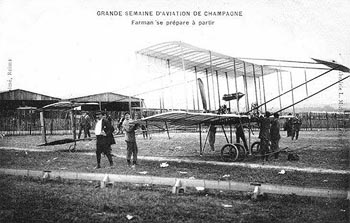 Henri Farman 3, most probably Reims, August, 1909 Noting the event being the 'Grande Semaine d'Aviation de Champagne' and at the side, Reims download a 750pixel image
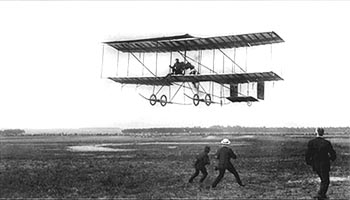 Henri Farman 3, Reims, August 28, 1909 download a 750pixel image
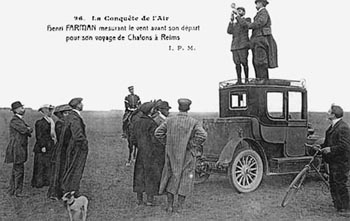 Henri Farman 3, checks the wind speed bfore his flight from Chalons to Reims, 1909 [to be confirmed - Ed] download a 750pixel image
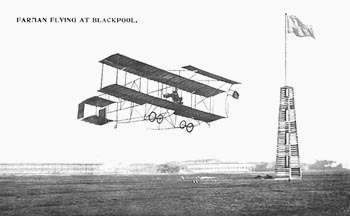 Henri Farman 3, Blackpool, England, c.1909 download a 1000pixel image
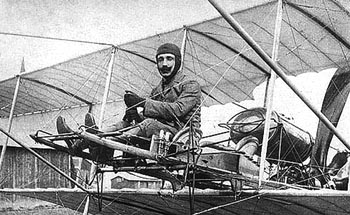 Henri Farman 3, pilot Lt. Notaras, Greek Air Corps The purpose of this image is to show 'cockpit' detail download a 750pixel image
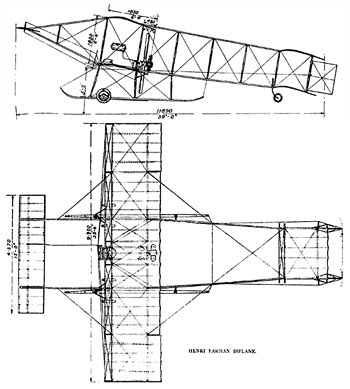 Henri Farman 'Biplane', (Type 3) download a 1000pixel JPG image or 1000pixel GIF image [300Kb]
and finally.... A 1911 Henri Farman IV Boxkite made and flown by Roger Freeman, President of the Vintage Avation Historical Foundation, Marion, Texas, per contract with Hong Kong 's new International Airport. This is a flying replica of the first aircraft to fly in China. It was delivered in late November of 1997 and it will hang from the ceiling of the new Air Terminal Lobby after performing several demonstrations in China.
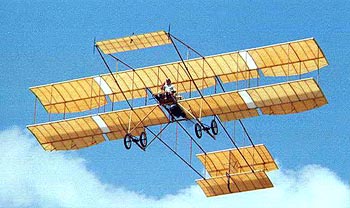
Replica 1911, Henri Farman IV Boxkite download a 750pixel image
Notes on http://members.lycos.co.uk say...
"In designing his aeroplane Henry Farman aimed to create a simpler and lighter version of the Voisin type which he had flown so successfully in 1908. The Farman was first displayed at the Rheims Meeting in August 1909. It was powered by the new Gnome rotary engine and proved itself very capable and practical. Like the Voisin, the engine was at the rear and the tail carried on four out-riggers.Specifications : Engine: 50 to 70 hp Gnome; Wing span: 32 feet 6 in.; Surface: 420 sq. ft.; Weight: 1,170 lb (with pilot); Speed: c.40 mph; Ceiling: c.6,000 feet; Endurance: 3 hours and also...
Duelling with the Wind
The Henri Farman IV Boxkite, a flying machine from the dawn of flight, looked ungainly in the morning light - all wood, wire and shellacked fabric. Owner Roger Freeman sat in the pilot's chair, hand on the throttle. Five feet behind him, a fixed-pitch, wooden prop ticked away.Henri Farman IV The most widely used and popular 'Farman' in Russia during 1909-1916. Hundreds of Russian aviators made their first flight on Farman IV. Only few Farman IV's were purchased in France. But many hundreds were built at various workshops and factories, ranging from homebuilts to large batches from 'Dux' and other serious manufacturers. As a result total number of built aircraft and its modifications are unaccountable. Most of them were powered by 50hp Gnome engine.
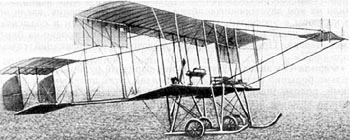 Henri Farman IV
Description provided by Prof. N.A. Rynin:
3-strut biplane with tail frame. Engine is mounted on the lower wing, driving pusher propeller. Ailerons had only lower control cables and were hanging down while aircraft is in rest. Aircraft is built of wooden elements, connected by very basic joints and enforced by bracing wires. Wing was covered with fabric only from below. As a result wing had 'not an airfoil but something unimaginable', as pilots giggled. But it was fine, thanks to very small wing load.The most common modification of F-4 included two-side fabric cover on the wing and ribs with more advanced airfoil. Those basic improvements, first performed by Russian aviators, allowed pilot M.A.Gaber-Vlynskij to set several ceiling records (April 13, 1913) : pilot with 5 passengers - 1120m ; pilot with 4 passengers - 1350m and pilot alone - 3000m
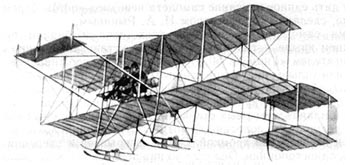 Henri Farman IV, winterised version
Some Russian Farman IV's were built of bamboo instead of pine. During winter season wheels were replaced by skis. Aircraft was not used for military purposes. Modifications :
Farman IV by 'Dux' factory had substantially increased wingspan, single rudder, landing skis were much longer (like on Farman III). Wing airfoil was not revised, but cover was on both sides. This aircraft was built in series under supervision of engineer V.V.Bartoshevich.References : "History of aircraft construction in the USSR" by V.B.Shavrov, Vol.1 p.140-143
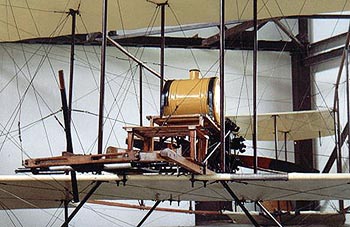 Henri Farman IV, 'cockpit' detail download a 750pixel image
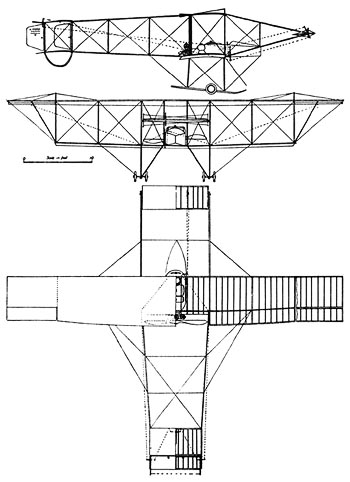 Farman-Michelin date? c. 1909-1911 download a 1000pixel JPG image or 1000pixel GIF image [230Kb]
and some links...
The Old Kingsbury Aerodrome
1910Henri Farman HF.C (is this the Farman 3?)Biplace de tourisme. Biplan. Moteur propulsif.
1911Henri Farman HF.2/2Biplace expérimental. Premier vol en mars 1911. Monoplan aile haute.
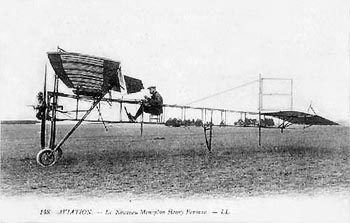 Henri Farman, HF.2/2
'Jéro' Farman HF.3
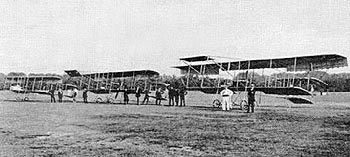 'Jéro' Farman HF.3 "Foto uit de verkoopsbrochure van de firma Jéro. De door Bollekens gebouwde toestellen op het vliegveld van St. Job" Jéro-Farman, license-built Farmans, built in Antwerp by Bollekens
Henri Farman HF.6 Biplace d' observation.. Premier vol en juin 1911. Biplan. Bipoutre. Henri Farman HF.7 Biplace d' observation. Biplan. Moteur propulsif. Henri Farman HF.10 Biplace d' observation. Biplan. Moteur propulsif. Henri Farman HF.10-1bis Triplace d' observation. Biplan. Moteur propulsif. Maurice Farman MF.6 Biplace de tourisme. Biplan. Moteur propulsif. The following images are referred at source as being either HF.3s or MF.7s. Not having the 'longhorn' skids at the front the trademark? of the MF.7 nor the even length wings of the HF3. I am guessing that these are actually MF.6 types. [To be researched. -Ed.]
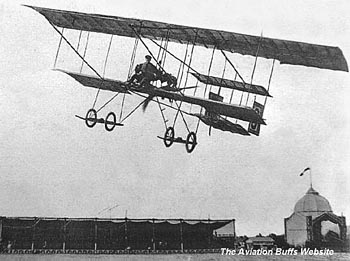 Maurice Farman MF.6?
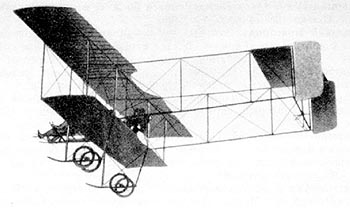 Maurice Farman MF.6? download a 750pixel image
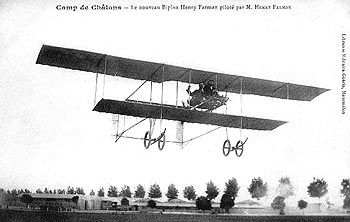 Maurice Farman MF.6? The card suggests that this is both by HF and flown by him. I believe that the pilot is indeed MF and thus the plane is by MF.[Ed.] download a 750pixel image
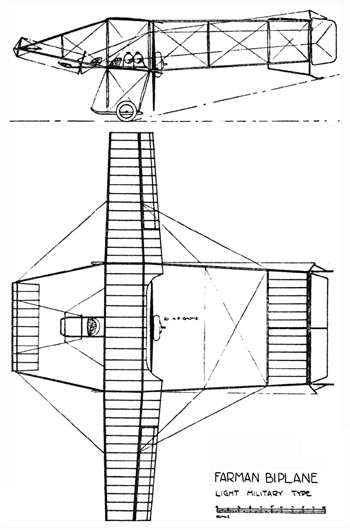 Henri Farman, Light Military Type, 1911 download a 1000pixel JPG image or 1000pixel GIF image [300Kb]
Henri Farman V, Bristol-Farman, Bristol Military Type English built, up-scaled copy of Farman IV. It was built with minor improvements for more powerful engine. Eight were purchased from Bristol Company for Gatchina and Sevastopol Aviator Schools, where they served in 1911-1913. References : "History of aircraft construction in the USSR" by V.B.Shavrov, Vol.1 p.143"
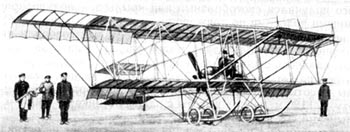 Henri Farman V, Bristol-Farman, Bristol Military Type
1912Henri Farman HF.14Biplace de tourisme. Premier vol en juillet 1912. Biplan. Moteur propulsif.
Farman XV (15) First of Farman's in Russian service equipped with normal cockpit. Construction includes both wood (wings) and steel tube (tail booms) elements. Lower wing is much smaller than the upper one, outer panels supported by kingposts. Designed as a reconnaissater in 1912. There were plans to protect it with armour, but large weight of this protection resulted in abandoning of armored Farman XV. In 1913 V.P.Poplavko used this aircraft for first (in Russia) experiments with machinegun (Maxim) installation (see picture). 18 Farman XV's were built at Dux factory, different from French built aircraft by slightly increased wingspan. Farman XV did not find wide use, smaller and lighter Farman XVI, XX and XXII were preferred by Russian aviators. 'Jéro' Farman HF.16 Biplace d' observation. Biplan. Moteur propulsif.
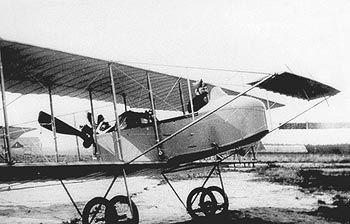 'Jéro' Farman HF.16 Lt. Wahis around 1912 Amilpress Photo download a 750pixel image
Farman XVI (16) http://www.ctrl-c.liu.se Differed from Farman XV by smaller wings (upper one is slightly swept back) and lower landing gear. It carried no armament (despite armour was planned for reconnaissance use). Since 1915 relegated to training use. In 1914 one Farman XVI was installed on skis and participated in Polar Expedition by Vilkitsky. One flight was performed by pilot Aleksandrov and mechanic Trykalov in the Providence Bay. During Winter stay aircraft was 'reassembled'... into airsled. Farman XVI was built on all major Russian aircraft factories, with total production up to 300. Henri Farman HF.19 Hydravion biplace de course. Biplan. Moteur propulsif, flotteurs.
1913Henri Farman HF.20Biplace de reconnaissance. Biplan. Moteur propulsif.
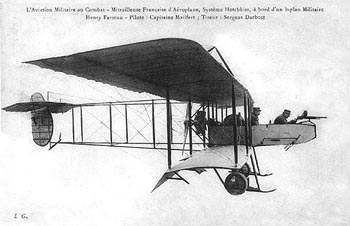 Henri Farman Light Military Type, 1913 this machine appears to be the HF.20 or from the the HF.20 series download a 750pixel image
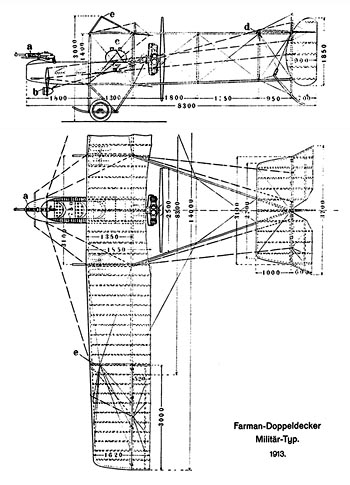 Henri Farman Light Military Type, 1913 this machine appears to be the HF.20 or from the the HF.20 series download a 1000pixel JPG image or 1000pixel GIF image [300Kb]
Farman F-XX (20) http://www.ctrl-c.liu.se Similar to Farman XVI, with refined design. Some construction elements were made lighter, other - strengthened. Some F-XX had dual controls. Aircraft was built at Anatra and Schetinin factories. Anatra continued production until 1922. Last Farman F-XX was serving at Sevastopol aviator school in 1923. Henri Farman HF.21 Biplace d' observation. Biplan. Moteur propulsif. Henri Farman HF.22 Biplace d' observation. Biplan. Moteur propulsif.
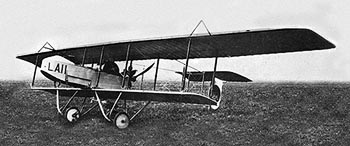 Henri Farman HF.22 download a 750pixel image
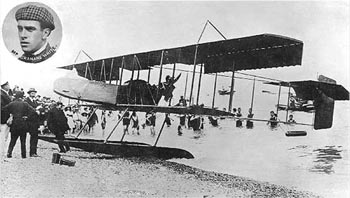 Henri Farman HF.22 Hydro download a 750pixel image http://members.shaw.ca/flyingaces/archive1.htm
Flown by J. L. Travers and Claude Graeme-White on their 'Wake Up England' campaign, July/August 1912. The Machine was covered in bright blue fabric and had the 'Wake Up England' slogan across the wings in bright yellow A 2view colour image of this craft appears in Munson, K., Pioneer Aircraft 1903-14, Blandford, 1969
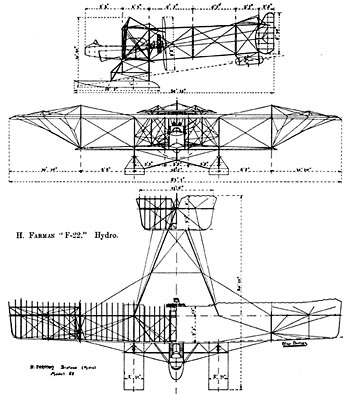 Henri Farman HF.22 Hydro download a 1000pixel JPG image or 1000pixel GIF image [300Kb]
'Jéro' Farman HF.22 same ac. as above HF.22?
Farman XXII (22), Farman XXIIbis, Farman XXII floatplane Farman XXII was very similar to its predecessors Farman XV, XVI and XX. Major difference - strengthened landing gear, using U-shaped steel tubes instead traditional N-struts. Since 1915 - served as trainer. Henri Farman HF.23 Biplace d' observation. Biplan. Moteur propulsif. Henri Farman HF.24 Biplace d' observation. Biplan. Moteur propulsif. Henri Farman HF.25 Biplace de tourisme. Biplan. Moteur propulsif. Maurice Farman MF.7 Biplace de reconnaissance. Premier vol en février 1913. Biplan. Moteur propulsif.
Maurice Farman MF.7, MF.1912, MF 'Longhorn', S.7 The Type VII was very similar to the Type IV, but with monoplane tailplane and slightly smaller. Booms of the tailframe became perfectly parallel. Front elevator was removed on some aircraft, without any change in performance and handling. Crew seats were shifted far forward. Variety of engines were used, tailplane cover could be single or two-sided.
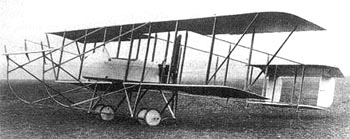 Maurice Farman MF.7 download a 750pixel image
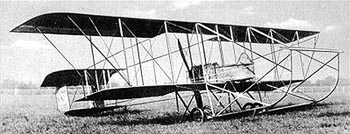 Maurice Farman MF.7 download a 750pixel image
Maurice Farman MF.7, MF.1912, MF 'Longhorn', S.7 http://www.worldwar1.com The design of the Farman MF.7, which first flew in 1913, was the culmination of the pre-war Farman design effort. A pusher design, it had a unique forward elevator positioned on curved extensions of the landing skids. It featured a biplane elevator located at the rear, supported by twin booms attached to the trailing portions of the top and bottom elevators. Dual mainwheels were mounted on skids and there were rubber shock absorbers. This configuration made the aircraft very easy to land, which, following its application as a viable military vehicle, meant that it soon adopted a role as an ideal primary trainer. more... Henri? Farman VII, F.7, Farman Racer, Military Type, Maurice Farman Very similar to the Henri? Farman IV, but with monoplane tailplane and slightly smaller. Booms of the tailframe became perfectly parallel. Front elevator was removed on some aircraft, without any change in performance and handling. Crew seats were shifted far forward. Variety of engines were used, whig/tailplane cover could be single or two-sided. Four 'Farman VII's first Russian pilots (volunteers) participated in Balkan War (1912). Modifications : Farman VII by A.A. Agafonov was built on Schetinin factory for record flight Petersburg-Sevastopol, planned for 1913. Upper wing span was increased, two additional large fuel tanks installed. This flight never took place, but many other flights were performed.References : "History of aircraft construction in the USSR" by V.B.Shavrov, Vol.1 p.144-145 Maurice Farman MF.8 Hydravion biplace de tourisme. Biplan. Flotteurs, moteur propulsif. Maurice Farman MF.9 Hydravion biplace de tourisme. Biplan. Flotteurs, moteur propulsif. Maurice Farman MF.16 Reconnaissance Monomoteur de transport. 1 seul exemplaire construit. Sesquiplan. Moteur propulsif.
1914Maurice Farman MF.111914 Biplace d'observation et de bombardement. Biplan. Moteur propulsif. The Maurice Farman 'Shorthorn' (sic) seems to have caught the writers eye on the web if not elsewhere. There are a multitude of sites carrying a multitude of facts and figures. - Ed.
Maurice Farman MF.11, MF.1914, MF 'Shorthorn', S.11 Henri Farman and his brother Maurice Farman, started their aviation company at Boulogne-sur-Seine in 1912. Two of their planes, the Farman MF.7 and the Farman MF.11, were popular Allied reconnaissance craft during the early stages of the war. They were purchased by both the French Army Air Service and the Royal Flying Corps before the outbreak of the First World War. They were also used by the Belgian and Italian air forces. The Royal Naval Air Service used the Farman MF.11 for its first night bombing mission when it attacked a German artillery installation on 21st December, 1914.
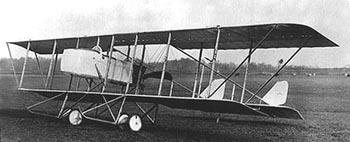 Maurice Farman MF.11 download a 750pixel image
Maurice Farman MF.11, MF.1914, MF 'Shorthorn', S.11 http://www.theaerodrome.com A biplane "pusher" developed by the French, the Farman S.11, more commonly known as the 'Shorthorn', lacked the characteristic forward elevator of the Farman 'Longhorn'. With the nacelle positioned half-way up the interplane struts, the pilot was seated well ahead of the wings and the aircraft was ideally suited to its initial role as a reconnaissance bomber. Adopted by most of the Allied air services, the 'Shorthorn' was often equipped with dual controls and widely used as a trainer throughout much of the war.
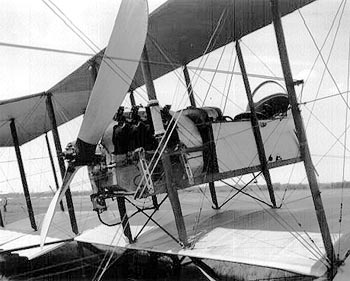 Maurice Farman MF.11 nacelle detail
Maurice Farman MF.11, MF.1914, MF 'Shorthorn', S.11 http://www.raafmuseum.com.au In 1916, the Australian Flying Corps(AFC) introduced the Farman 'Shorthorn' into service as a trainer at Point Cook. CFS-15 was the first of type into service, and until replacement by more modern trainers in 1919, was used to train pilots in the AFC for service both at home and overseas. In 1919, Mr R.G. Carey of Port Melbourne purchased CFS-15 for use in advertising, joyflights and barnstorming, now registered as G-AUBC.
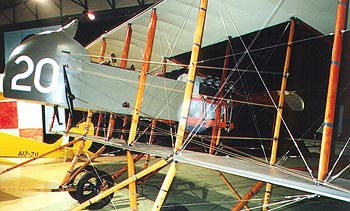 Maurice Farman MF.11, RAAF Museum, Point Cook, Victoria, Australia The machine CFS-20, a beautifully restored composite of the four original machines at Point Cook Central Flying School download a 1000pixel image
Carey flew the aircraft until the 1930's, after which it was stored. By the 1980's, the aircraft had virtually disappeared, and in 1981, Carey's daughter donated the remaining components to the RAAF Museum. After the completion of the Demon project in 1986, the Museum began the restoration of CFS-15 for display. Containing approximately 30% original parts, and fitted with a 75hp Wolseley-Renault engine, CFS-15 was put on display in 1997.
Maurice Farman MF.11, MF.1914, MF 'Shorthorn', S.11 The Farman 'Shorthorn' was designed and built in France by a pioneer aeroplane manufacturing company established by the Farman brothers. The 'Shorthorn' became the first armed aircraft to engage in aerial combat during World War I. Its most noted service activity was as a training aircraft with No 5 Australian Flying Corps (Training) Squadron in the United Kingdom and with the Central Flying School (CFS) at Point Cook. more...
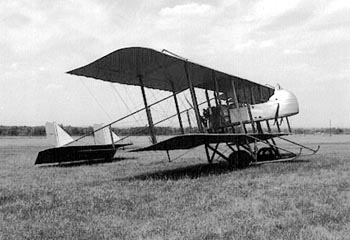 Maurice Farman MF.11
Maurice Farman MF.11, MF.1914, MF 'Shorthorn', S.11 http://www.worldwar1.com The Farman MF.11 was widely produced under licence in Great Britain (where it was known as 'Shorthorn') Russia and Italy. Introduced in late 1915, it equipped many reconnaissance squadrons, where it was appreciated for its good flying qualities, particularly in mountaina areas. It was equipped with Renault and de Dion Bouton engines, later replaced by Fiat A 10 engines. Its initial producer was the Savoia company, later followed by Fiat, which designated it F.5b, and by Macchi, Zari and Vickers Terni. Armed with a frontal Fiat machine gun, the Farman survived many encounters with enemy fighters, and it was also used as a bomber, particularly by the 31a squadriglia in the Alpine region. A later Italian version was the so-called Farman Colombo, or MF.C, with a Colombo D.110 110 hp engine, that featured an oval nacelle. more...
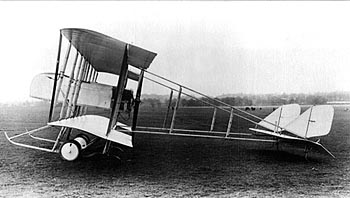 Maurice Farman MF.11 download a 750pixel image
Maurice Farman MF.11, MF.1914, MF 'Shorthorn', S.11 http://www.accessweb.com The Farman 'Shorthorn' carried it's crew tandem, the observer in front, the pilot behind. The British used MF.1914s as bombers in 1914 in the Dardanelles, in Africa and Mesopotamia, with 80 assigned to the Royal Navy. The French used early types on the eastern front and in Macedonia. The MF.1914s assigned to the Belgans flew bombing missions against German submarines and Zeppelin bases. A Farman of 1 Wing was credited with destroying a Zeppelin at Evere. By 1915 the plane became useless against the mounting aerial opposition from the Germans, who had a new Fokker monoplane, and it was quickly relegated to training pilots in England. more...
Maurice Farman MF.11, MF.1914, MF 'Shorthorn', S.11 The MF.11 'Shorthorn' was a development of the MF.7 'Longhorn' and the official British name was the S.11, but this never really caught on. These aircraft were most deserving of the name 'string-bag' as they were held together with a veritable maze of wire. The main difference between them was the use of rear elevators instead of canard elevators on the 'Longhorn'. The name 'Longhorn' was given on account of the long curved sticks used to mount the canard elevator, and the 'Shorthorn' only retained the vestige of these as skids protruding in front of the undercarriage to prevent nose-overs. more... Maurice Farman MF.11bis, MF130ch
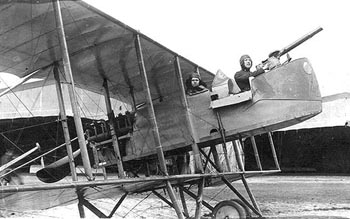 Maurice Farman MF.11bis KLM/MRA Collection. download a 750pixel image
A development of the Maurice Farman MF.7 "Longhorn", the MF.11 has upper- and lower-wing ailerons and an improved and enlarged nacelle. The aircraft also lost the typical MF.7 front elevator and skids which inevitably gave it its name "Shorthorn". The fact that the observer/gunner was sitting behind the pilot severely limited the defence possibilities for the MF.11. A later version called the MF.11bis solved this problem by positioning the observer (now armed with Lewis or Hotchkiss gun) in front of the pilot in a new elongated nacelle. and for even more about the 'Shorthorn'... Maurice Farman MF.13, 14
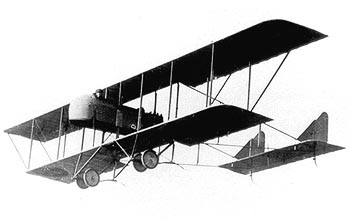 Maurice Farman Type 1914 "Shorthorn" in flight near its base at Koksijde probably in 1915 The designation MF.13 (or MF.130hp) reflected the aircraft's engine horsepower, while the MF.14 desination reflected the model 1914 of the same Farman MF.11/MF.11bis design. Mike Terlinden Collection. download a 750pixel image
an aircraft that needs more research
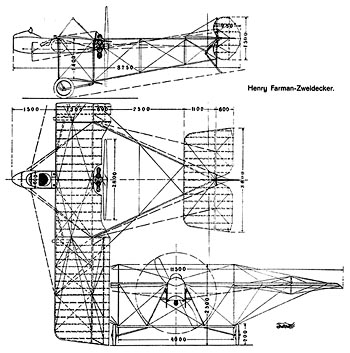 Henri Farman Monoplane of 1914 download a 1000pixel JPG image or 1000pixel GIF image [370Kb]
1915Henri Farman HF.27Triplace de reconnaissance. Biplan. Moteur propulsif. Henri Farman HF.30 Biplace de reconnaissance. Premier vol en décembre 1915. Biplan. Moteur propulsif.
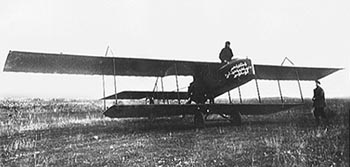 Henri Farman HF.30
Henri Farman HF.33 Biplace de chasse. Biplan. Moteur propulsif. Farman F.40 Biplace d' observation. Biplan. Moteur propulsif. Bois et toile.
Farman F.40 "...The Farman F.40 entered service with the French air service in June of 1915 and was not an immediate success. Criticisms were made not only of its performance, but of its structural integrity, and the quality of both construction and of the materials used. A crash program of improvements was initiated, but by the time of its completion the big pusher was well past obsolete. Nonetheless it was built in large enough numbers to equip more than forty escadilles and saw wide service in a variety of roles on the western front and overseas, it also served with the forces of almost every other allied nation and was produced under licence in Italy and elsewhere. Possessing features of both Maurice and Henri Farman designs the F40 was sometimes referred to as the "Horace" Farman."
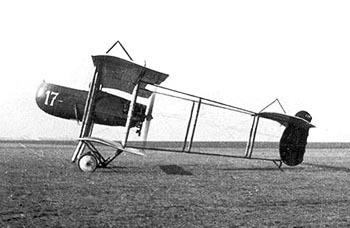 Farman F.40 Farman Type 40 (Engine Renault 130 hp) of the Aéronautique Militaire seen at Houtem in the Spring 1915. Arch. KLM/MRA (AMBIVP6)
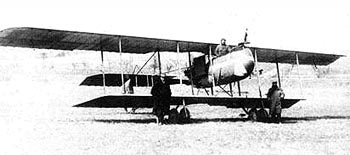 Farman F.40
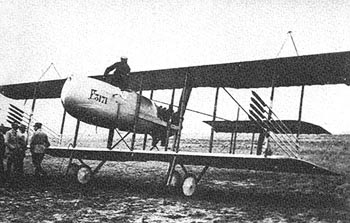 Farman F.40 fitted with Le Prieur Rockets Read more about Yves Paul Gaston Le Prieur
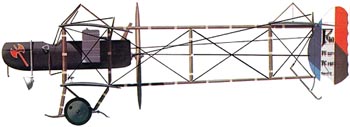 Farman F.40 a damaged image but none the less, good detail shot of nacelle etc. - Ed. download a 750pixel image
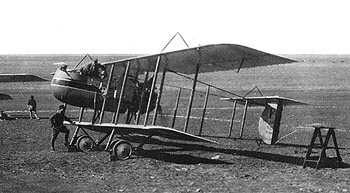 Farman F.40 download a 750pixel image
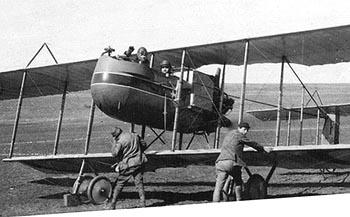 Farman F.40 download a 750pixel image
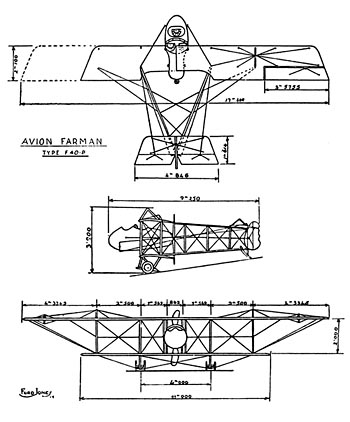 Henri Farman F.40 P download a 1000pixel JPG image or 1000pixel GIF image [300Kb]
Farman F.40 type 46 Biplace d' observation. Biplan. Moteur propulsif. Bois et toile. Farman F.41 Biplace de reconnaissance. Biplan. Moteur propulsif.
1916Henri Farman HF.36Biplace de chasse. Premier vol en juillet 1916. 1 seul exemplaire construit. Sesquiplan. Farman F.30A Biplace de chasse. Premier vol en décembre 1916. 1 seul exemplaire construit transformé ensuite en Farman F.30B Biplan. Farman F.40bis Biplace de reconnaissance. Biplan. Moteur propulsif. Farman F.40ter Biplace de reconnaissance. Biplan. Moteur propulsif. Farman F.41bis Biplace de reconnaissance. Biplan. Moteur propulsif. Farman F.43 Biplace de reconnaissance. Biplan. Moteur propulsif. Farman F.45 Biplace de reconnaissance. Biplan. Farman F.1, 40 Biplace de reconnaissance. Biplan. Moteur propulsif. Farman F.1, 40bis type 60 Biplace de reconnaissance. Biplan. Moteur propulsif. Farman F.1, 40ter type 61 Biplace de reconnaissance. Biplan. Moteur propulsif.
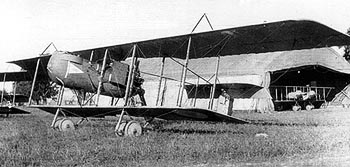 Farman F.1, 40ter type 61 Villeselve durant l'été 1917 download a 750pixel image
Farman F.1, 40bis type 70 Hydravion biplace de d'entrainement. Biplan. Moteur propulsif. Farman F.1, 41 type 70 Biplace de reconnaissance. Biplan. Moteur propulsif. Farman F.1, 41bis type 70 Biplace de reconnaissance. Biplan. Moteur propulsif. Farman-Nélis GN.1, GN.2, GN.3, GN.4, GN.5 and GN.6
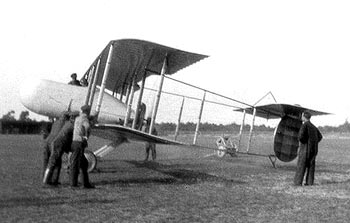 Farman-Nélis GN.1 Guy Van de Merckt Collection download a 750pixel image
When the Aviation Militaire had regrouped all deep maintenance at Calais- Le Beau-Marais, its director Georges Nélis and designer Demonty started developing new version of the proven Farman pusher type of aircraft. Up to now six different models/aircraft have been identified as GN.1 to GN.6, each being different by its layout, engine or radiator positioning. The above photograph shows the first model the GN.1, equipped with a rotating Gnôme-Rhône engine and regular but already streamlined fuselage.
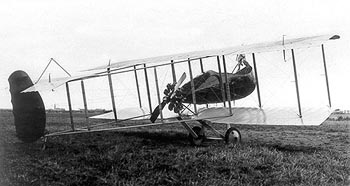 Farman-Nélis GN.2 GN 2 of the team Jacquet-Robin with reprofiled fuselage contours and still powered by a Gnôme-Rhône engine. Guy Van de Merckt Collection download a 750pixel image
1917Farman F.30BBiplace de chasse. Premier vol en juillet 1917. 1 seul exemplaire construit, le Farman F.30A transformé. Biplan. Farman F.47 Biplace de reconnaissance. Biplan. Farman F.48 Biplace de reconnaissance. Biplan. Farman F.49 Biplace de reconnaissance. Biplan. Farman F.41H Hydravion biplace de reconnaissance. Biplan. Moteur propulsif.
This next grouping needs further research as there appears to be a Maurice Farman F.60 'Goliath' series (a development of the Shorthorn/Longhorn for night bombing) and a Henri/Maurice Farman F.60 'Goliath' series which were substantially larger, produced into the mid to late 1920s. A converted F.60 of the latter series was used for the first international passenger service when it carried 12 passengers from London to Paris in February 1919. Maurice Farman F.60 'Goliath' Heavy Night Bomber
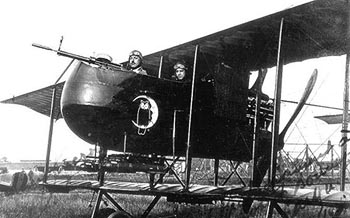 Farman F60 The first Farman F.60 night-bomber of the newly created 8th squadron based at Coudekerke. Pilot Lacroix and gunner de Burlet. Mike Terlinden Collection download a 750pixel image
Maurice Farman F.60 'Goliath' Hidroavión utilizado en la primera época de la Escuela de Hidroaviación Motores: 2 Gnome R.9A, 380 HP. Maurice Farman F.61 'Goliath' Heavy Night Bomber
Maurice Farman F.61 Maurice Farman F.62 Heavy Night Bomber Maurice Farman F.63 Heavy Night Bomber Maurice Farman F.65 Seaplane Bomber
1918Farman F.30B, AR2Biplace de chasse. 1 seul exemplaire construit le Farman F.30B modifié. Sesquiplan. Henri Farman HF.31 Biplace de chasse. Premier vol en août 1918. 1 seul construit. Biplan. Farman F.46 Biplace d'entrainement Biplan. Moteur propulsif, train à 8 roues. Farman F.50 Bombardier lourd. Triplace de bombardement. Biplan. Farman F.1, 46 Biplace d'entrainement. Biplan. Moteur propulsif. Farman F.2, 40 Biplace de reconnaissance. Biplan. Moteur propulsif.
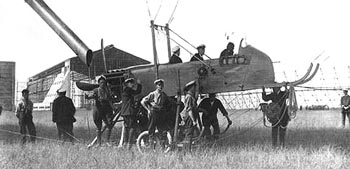 Farman Balloon Nacelle download a 750pixel image
|
© Copyright 1999-2002 CTIE - All Rights Reserved - Caution |
